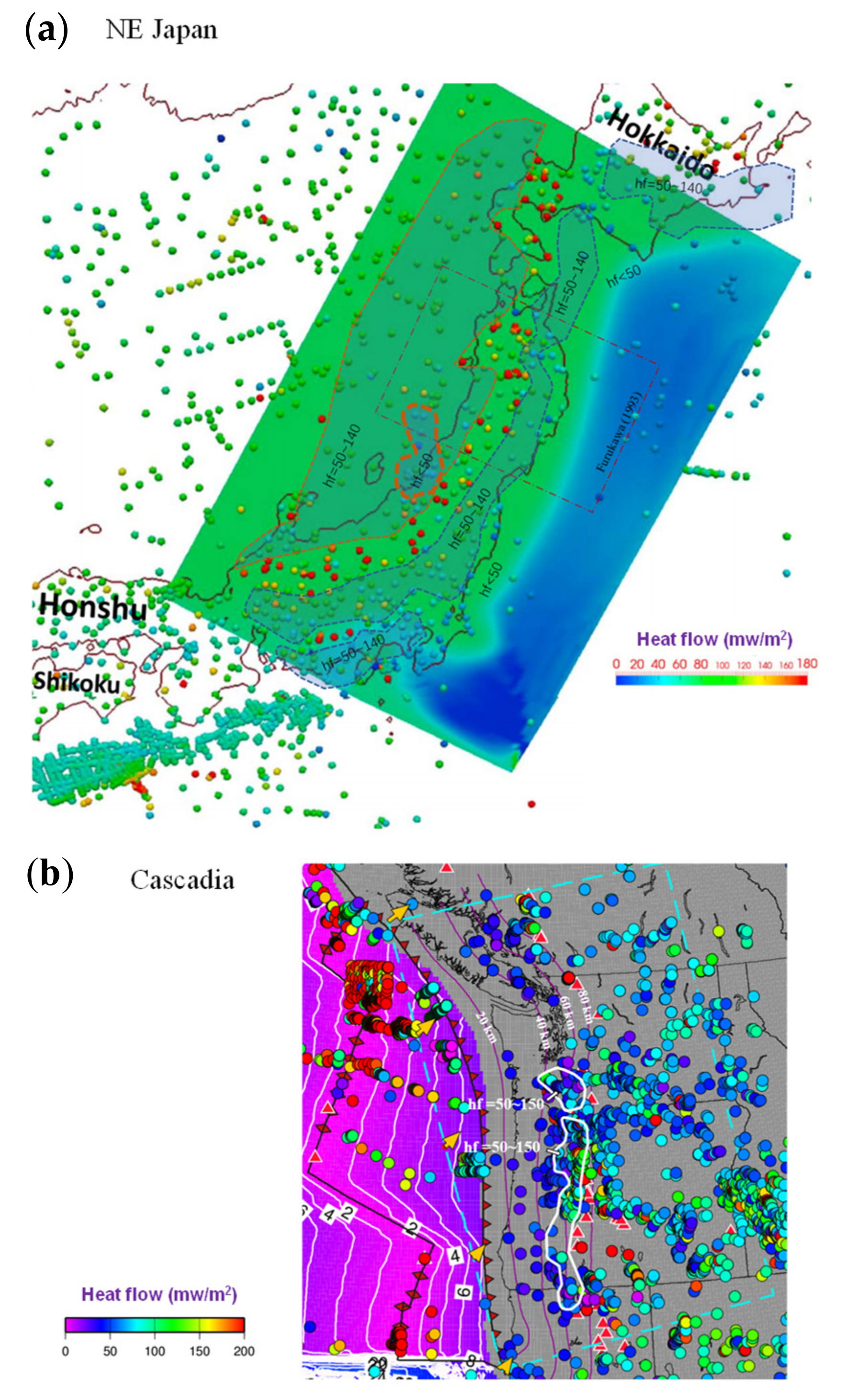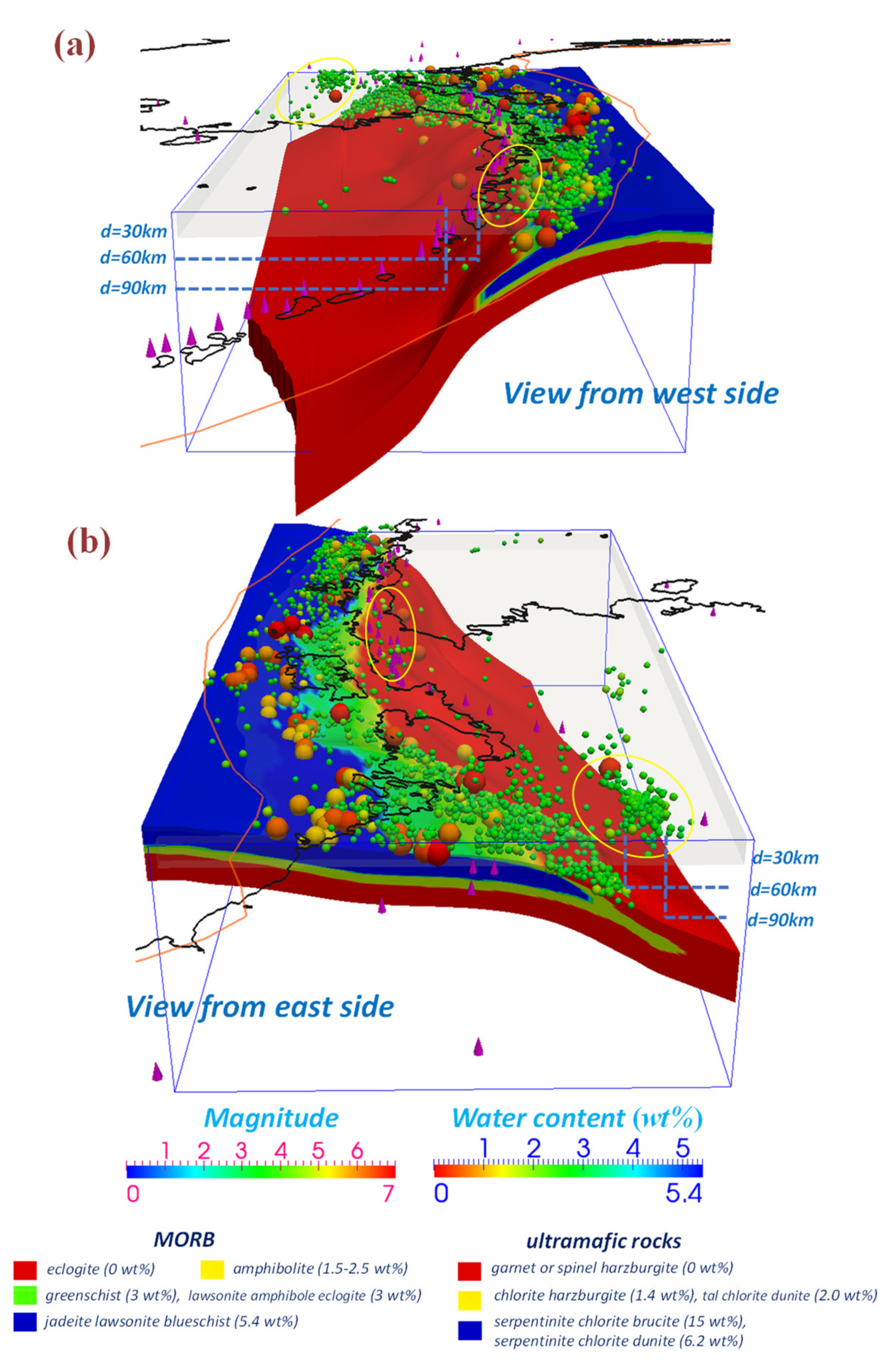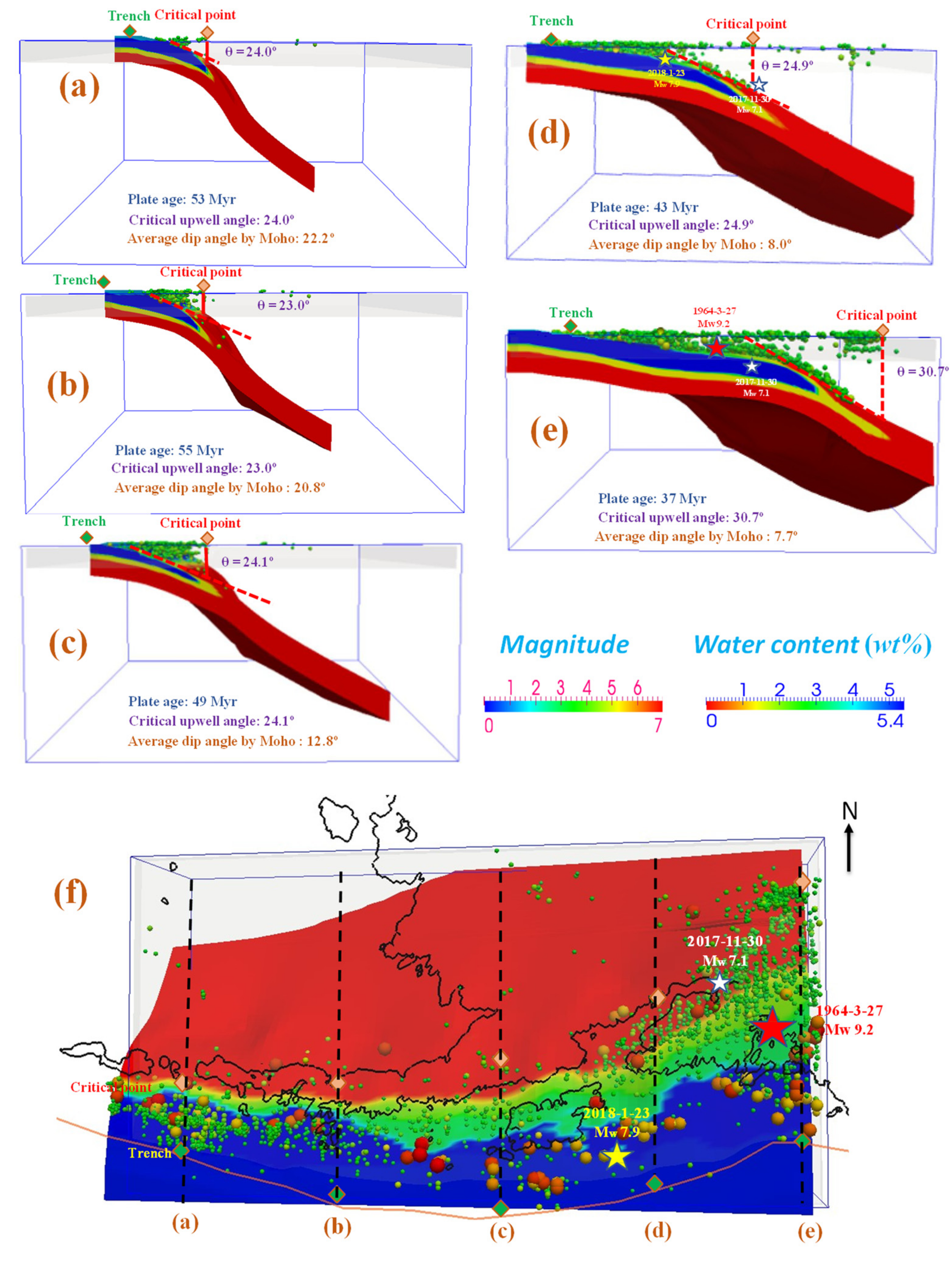Variations in Wedge Earthquake Distribution along the Strike Underlain by Thermally Controlled Hydrated Megathrusts
Abstract
:Featured Application
Abstract
1. Introduction
2. Materials and Methods
3. Results
3.1. Constrained Thermal Regime Beneath the Alaskan Continental Wedge
3.2. Variations in Wedge-Earthquake Distribution along the Strike
4. Discussion
5. Conclusions
- (1)
- The subduction thermal regime constrained by the observations of surface heat flow, including Currie depth estimations without plate decoupling, well interprets the thermal state of the underlain subducted plate beneath the wedge wherein earthquakes occurred.
- (2)
- The distribution of wedge-earthquake variations in Alaska features a transition from steep subduction to flat subduction associated with different subduction hydrothermal states and fluids released. The farthermost point of the hypocenter of wedge earthquakes from the trench is determined by the slab dip angle and the slab surface depth of 60 km.
- (3)
- The across-arc width of the wedge-earthquake source zone is consistent with the across-arc width of the surface high topography above the entirely dehydrated plate interface, and the fluid upwelling spontaneously influences forearc seismotectonics and orogenesis.
Author Contributions
Funding
Institutional Review Board Statement
Informed Consent Statement
Acknowledgments
Conflicts of Interest
References
- Lin, C.-H.; Shih, M.-H.; Lai, Y.-C. Mantle wedge diapirs detected by a dense seismic array in Northern Taiwan. Sci. Rep. 2021, 11, 1–12. [Google Scholar]
- Gerya, T.V.; Connolly, J.A.; Yuen, D.A.; Gorczyk, W.; Capel, A.M. Seismic implications of mantle wedge plumes. Phys. Earth Planet. Inter. 2006, 156, 59–74. [Google Scholar] [CrossRef]
- Tape, C.; Sykes, L.; Lomax, A. The 1900 M w 7.6–8.0 Earthquake Offshore of Kodiak Island, Alaska. Bull. Seismol. Soc. Am. 2021, 111, 1080–1109. [Google Scholar]
- Gerya, T.V.; Stöckhert, B.; Perchuk, A.L. Exhumation of high-pressure metamorphic rocks in a subduction channel: A numerical simulation. Tectonics 2002, 21, 6-1–6-19. [Google Scholar] [CrossRef] [Green Version]
- Tamura, Y.; Tatsumi, Y.; Zhao, D.; Kido, Y.; Shukuno, H. Hot fingers in the mantle wedge: New insights into magma genesis in subduction zones. Earth Planet. Sci. Lett. 2002, 197, 105–116. [Google Scholar] [CrossRef]
- Martin-Short, R.; Allen, R.; Bastow, I.D.; Porritt, R.W.; Miller, M.S. Seismic imaging of the Alaska subduction zone: Implications for slab geometry and volcanism. Geochem. Geophys. Geosyst. 2018, 19, 4541–4560. [Google Scholar] [CrossRef]
- Worthington, L.L.; Van Avendonk, H.J.; Gulick, S.P.; Christeson, G.L.; Pavlis, T.L. Crustal structure of the Yakutat terrane and the evolution of subduction and collision in southern Alaska. J. Geophys. Res. Solid Earth 2012, 117. [Google Scholar] [CrossRef]
- Arcay, D.; Tric, E.; Doin, M.-P. Numerical simulations of subduction zones: Effect of slab dehydration on the mantle wedge dynamics. Phys. Earth Planet. Inter. 2005, 149, 133–153. [Google Scholar] [CrossRef]
- Tackley, P.J.; Xie, S. STAG3D: A code for modeling thermo-chemical multiphase convection in Earth’s mantle. In Computational Fluid and Solid Mechanics; Elsevier Science Ltd.: Amsterdam, The Netherlands, 2003; pp. 1524–1527. [Google Scholar]
- Ji, Y.; Yoshioka, S.; Matsumoto, T. Three-dimensional numerical modeling of temperature and mantle flow fields associated with subduction of the Philippine Sea plate, southwest Japan. J. Geophys. Res. Solid Earth 2016, 121, 4458–4482. [Google Scholar] [CrossRef]
- Ji, Y.; Yoshioka, S.; Manea, V.C.; Manea, M.; Matsumoto, T. Three-dimensional numerical modeling of thermal regime and slab dehydration beneath Kanto and Tohoku, Japan. J. Geophys. Res. Solid Earth 2017, 122, 332–353. [Google Scholar] [CrossRef] [Green Version]
- Hayes, G.P.; Moore, G.L.; Portner, D.E.; Hearne, M.; Flamme, H.; Furtney, M.; Smoczyk, G.M. Slab2, a comprehensive subduction zone geometry model. Science 2018, 362, 58–61. [Google Scholar] [CrossRef]
- DeMets, C.; Gordon, R.G.; Argus, D.; Stein, S. Current plate motions. Geophys. J. Int. 1990, 101, 425–478. [Google Scholar] [CrossRef] [Green Version]
- DeMets, C.; Dixon, T.H. New kinematic models for Pacific-North America motion from 3 Ma to present, I: Evidence for steady motion and biases in the NUVEL-1A model. Geophys. Res. Lett. 1999, 26, 1921–1924. [Google Scholar] [CrossRef] [Green Version]
- Müller, R.D.; Sdrolias, M.; Gaina, C.; Roest, W.R. Age, spreading rates, and spreading asymmetry of the world’s ocean crust. Geochem. Geophys. Geosyst. 2008, 9. [Google Scholar] [CrossRef]
- Stein, C.A.; Stein, S. A model for the global variation in oceanic depth and heat flow with lithospheric age. Nature 1992, 359, 123–129. [Google Scholar] [CrossRef]
- Grose, C.J.; Afonso, J.C. Comprehensive plate models for the thermal evolution of oceanic lithosphere. Geochem. Geophys. Geosyst. 2013, 14, 3751–3778. [Google Scholar] [CrossRef]
- Yoshii, T. Regionality of group velocities of Rayleigh waves in the Pacific and thickening of the plate. Earth Planet. Sci. Lett. 1975, 25, 305–312. [Google Scholar] [CrossRef]
- Pollack, H.N.; Hurter, S.J.; Johnson, J.R. Heat flow from the Earth’s interior: Analysis of the global data set. Rev. Geophys. 1993, 31, 267–280. [Google Scholar] [CrossRef]
- Li, C.-F.; Lu, Y.; Wang, J. A global reference model of Curie-point depths based on EMAG2. Sci. Rep. 2017, 7, 1–9. [Google Scholar] [CrossRef]
- Omori, S.; Kita, S.; Maruyama, S.; Santosh, M. Pressure–temperature conditions of ongoing regional metamorphism beneath the Japanese Islands. Gondwana Res. 2009, 16, 458–469. [Google Scholar] [CrossRef]
- Hacker, B.R.; Abers, G.A.; Peacock, S.M. Subduction factory 1. Theoretical mineralogy, densities, seismic wave speeds, and H2O contents. J. Geophys. Res. Solid Earth 2003, 108. [Google Scholar] [CrossRef]
- Wada, I.; Wang, K. Common depth of slab-mantle decoupling: Reconciling diversity and uniformity of subduction zones. Geochem. Geophys. Geosyst. 2009, 10. [Google Scholar] [CrossRef]
- Furukawa, Y. Depth of the decoupling plate interface and thermal structure under arcs. J. Geophys. Res. Solid Earth 1993, 98, 20005–20013. [Google Scholar] [CrossRef]
- Peacock, S.M.; Wang, K. Seismic consequences of warm versus cool subduction metamorphism: Examples from southwest and northeast Japan. Science 1999, 286, 937–939. [Google Scholar] [CrossRef] [Green Version]
- Wada, I.; Wang, K.; He, J.; Hyndman, R.D. Weakening of the subduction interface and its effects on surface heat flow, slab dehydration, and mantle wedge serpentinization. J. Geophys. Res. Solid Earth 2008, 113. [Google Scholar] [CrossRef]
- Ashi, J.; Tokuyama, H.; Ujiie, Y.; Taira, A. Heat flow estimation from gas hydrate BSRs in the Nankai Trough: Implications for thermal structures of the Shikoku Basin. EOS Trans. AGU 1999, 80, F929–F930. [Google Scholar]
- Ashi, J.; Tokuyama, H.; Taira, A. Distribution of methane hydrate BSRs and its implication for the prism growth in the Nankai Trough. Mar. Geol. 2002, 187, 177–191. [Google Scholar] [CrossRef]
- Tanaka, A. Geothermal gradient and heat flow data in and around Japan (II) Crustal thermal structure and its relationship to seismogenic layer. Earth Planets Space 2004, 56, 1195–1199. [Google Scholar] [CrossRef] [Green Version]
- Tanaka, A.; Yamano, M.; Yano, Y.; Sasada, M. Geothermal gradient and heat flow data in and around Japan (I): Appraisal of heat flow from geothermal gradient data. Earth Planets Space 2004, 56, 1191–1194. [Google Scholar] [CrossRef] [Green Version]
- Matsumoto, T. Terrestrial heat flow distribution in Japan area based on the temperature logging in the borehole of NIED Hi-net. In Proceedings of the AGU Fall Meeting Abstracts, San Francisco, CA, USA, 10–14 December 2007. Abstract ID T23A-1217. [Google Scholar]
- Oleskevich, D.; Hyndman, R.; Wang, K. The updip and downdip limits to great subduction earthquakes: Thermal and structural models of Cascadia, south Alaska, SW Japan, and Chile. J. Geophys. Res. Solid Earth 1999, 104, 14965–14991. [Google Scholar] [CrossRef]
- Van Keken, P.E.; Kiefer, B.; Peacock, S.M. High-resolution models of subduction zones: Implications for mineral dehydration reactions and the transport of water into the deep mantle. Geochem. Geophys. Geosyst. 2002, 3, 1–20. [Google Scholar] [CrossRef]
- Van Keken, P.E.; Wada, I.; Abers, G.A.; Hacker, B.R.; Wang, K. Mafic high-pressure rocks are preferentially exhumed from warm subduction settings. Geochem. Geophys. Geosyst. 2018, 19, 2934–2961. [Google Scholar] [CrossRef] [Green Version]
- Wilson, C.R.; Spiegelman, M.; van Keken, P.E.; Hacker, B.R. Fluid flow in subduction zones: The role of solid rheology and compaction pressure. Earth Planet. Sci. Lett. 2014, 401, 261–274. [Google Scholar] [CrossRef]
- Syracuse, E.M.; van Keken, P.E.; Abers, G.A. The global range of subduction zone thermal models. Phys. Earth Planet. Inter. 2010, 183, 73–90. [Google Scholar] [CrossRef]
- Penniston-Dorland, S.C.; Kohn, M.J.; Manning, C.E. The global range of subduction zone thermal structures from exhumed blueschists and eclogites: Rocks are hotter than models. Earth Planet. Sci. Lett. 2015, 428, 243–254. [Google Scholar] [CrossRef] [Green Version]
- Ponko, S.C.; Peacock, S.M. Thermal modeling of the southern Alaska subduction zone: Insight into the petrology of the subducting slab and overlying mantle wedge. J. Geophys. Res. Solid Earth 1995, 100, 22117–22128. [Google Scholar] [CrossRef]
- Zhao, D.; Yu, S.; Liu, X. Seismic anisotropy tomography: New insight into subduction dynamics. Gondwana Res. 2016, 33, 24–43. [Google Scholar] [CrossRef] [Green Version]
- Siebert, L.; Simkin, T.; Kimberly, P. Volcanoes of the World; University of California Press: Berkeley, CA, USA, 2010. [Google Scholar]
- Horton, B.K. Tectonic regimes of the central and southern Andes: Responses to variations in plate coupling during subduction. Tectonics 2018, 37, 402–429. [Google Scholar] [CrossRef]
- Schütt, J.M.; Whipp, D.M. Controls on continental strain partitioning above an oblique subduction zone, Northern Andes. Tectonics 2020, 39, e2019TC005886. [Google Scholar] [CrossRef] [Green Version]
- Cashman, K.V.; Sparks, R.S.J.; Blundy, J.D. Vertically extensive and unstable magmatic systems: A unified view of igneous processes. Science 2017, 355, eaag3055. [Google Scholar] [CrossRef] [Green Version]
- Tan, E.; Lavier, L.L.; Van Avendonk, H.J.; Heuret, A. The role of frictional strength on plate coupling at the subduction interface. Geochem. Geophys. Geosyst. 2012, 13. [Google Scholar] [CrossRef]





Publisher’s Note: MDPI stays neutral with regard to jurisdictional claims in published maps and institutional affiliations. |
© 2021 by the authors. Licensee MDPI, Basel, Switzerland. This article is an open access article distributed under the terms and conditions of the Creative Commons Attribution (CC BY) license (https://creativecommons.org/licenses/by/4.0/).
Share and Cite
Qu, R.; Ji, Y.; Zhu, W. Variations in Wedge Earthquake Distribution along the Strike Underlain by Thermally Controlled Hydrated Megathrusts. Appl. Sci. 2021, 11, 7268. https://doi.org/10.3390/app11167268
Qu R, Ji Y, Zhu W. Variations in Wedge Earthquake Distribution along the Strike Underlain by Thermally Controlled Hydrated Megathrusts. Applied Sciences. 2021; 11(16):7268. https://doi.org/10.3390/app11167268
Chicago/Turabian StyleQu, Rui, Yingfeng Ji, and Weiling Zhu. 2021. "Variations in Wedge Earthquake Distribution along the Strike Underlain by Thermally Controlled Hydrated Megathrusts" Applied Sciences 11, no. 16: 7268. https://doi.org/10.3390/app11167268
APA StyleQu, R., Ji, Y., & Zhu, W. (2021). Variations in Wedge Earthquake Distribution along the Strike Underlain by Thermally Controlled Hydrated Megathrusts. Applied Sciences, 11(16), 7268. https://doi.org/10.3390/app11167268





